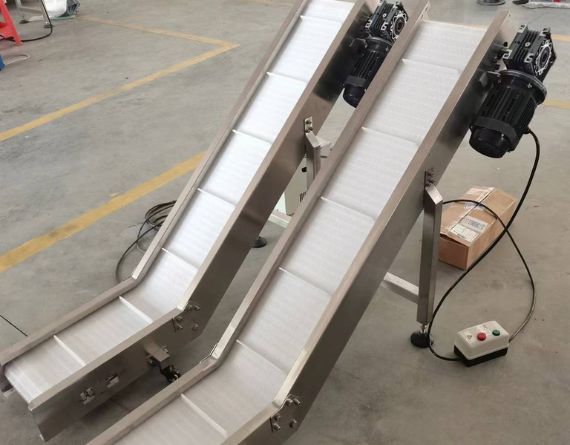Наклонный конвейер
Плавное, контролируемое движение продукта вниз
Что такое наклонный конвейер?
А конвейерная лента для снижения представляет собой наклонную конвейерную систему, используемую для перемещения предметов от более высоких высот к более низким безопасным и контролируемым образом. Эти конвейеры имеют привод или гравитационную подачу и могут быть настроены в зависимости от скорости, угла и типа нагрузки.
В отличие от наклонных конвейеров, которые толкают предметы вверх, наклонные конвейеры управляют силой тяжести, с использованием тормозные системы и трение поверхности ремня замедлить движение продукта. Цель — предотвратить повреждение продукта и обеспечить плавные переходы, особенно для хрупких или дорогостоящих товаров.
Вот как это работает:
Конвейер наклонен вниз, обычно под углом от 5° до 25°, в зависимости от области применения.
Скорость и движение регулирует моторизованный ремень, часто с противоскользящим покрытием.
Для предотвращения выхода продукции из-под контроля могут быть добавлены тормозные ролики или упоры.
Его можно использовать с приводным ремнем или как гравитационное снижение, в зависимости от требований к потоку.
Этот тип системы широко используется в таких отраслях, как логистика, переработка пищевых продуктов, дистрибуция, электронная коммерция и производство, особенно там, где вертикальное пространство оптимизировано, а безопасность является приоритетом. Наклонный конвейер — это разумное усовершенствование желобов или ручных методов транспортировки, предлагающее как эргономичные улучшения и постоянство пропускной способности
Технические характеристики
Вот краткий обзор наших стандартных и настраиваемых опций для конвейерные ленты снижения:
| Особенность | Спецификация |
|---|---|
| Тип конвейера | Энергоснабжение или гравитационный спад |
| Варианты ширины ремня | 200 мм - 1200 мм (доступны индивидуальные размеры ширины) |
| Материалы рамы | Нержавеющая сталь / Углеродистая сталь с порошковым покрытием |
| Диапазон угла наклона | от 5° до 25° (регулируемый или фиксированный) |
| Поверхность ремня | Противоскользящие ПУ/ПВХ, пищевые или сверхпрочные варианты |
| Контроль скорости | Переменная (ручная ручка или цифровой интерфейс) |
| Грузоподъемность | До 50 кг/метр (зависит от модели) |
| Параметры привода | Двигатель переменного тока, двигатель постоянного тока или сервопривод |
| Сертификаты | CE, ISO 9001, FDA (для пищевых продуктов) |


Наклонный и наклонный конвейеры — в чем разница?
Хотя оба типа необходимы для вертикального транспорта, они выполняют противоположные функции. Вот как они сравниваются:
| Особенность | Наклонный конвейер | Наклонный конвейер |
|---|---|---|
| Направление | Сверху вниз | Снизу вверх |
| Основное использование | Безопасный спуск грузов | Подъем предметов на большую высоту |
| Механизм управления | Регулировка скорости, торможение, гравитационный поток | Ремни с высоким коэффициентом трения, планки, силовой привод |
| Фокус на применении | Складирование, постобработка, упаковка | Сборочные линии, зоны загрузки |
| Фактор риска | Скольжение, свободное падение (без тормозов) | Проскальзывание или откат (без шипов) |
Совет профессионала: Многие учреждения используют оба варианта одновременно для U-образные производственные схемы, перемещение товаров вверх с помощью наклонного конвейера и вниз с помощью наклонного конвейера для рециркуляции или переупаковки.
Оптимизация рабочего процесса с помощью наклонных конвейеров
Интеграция конвейер для снижения в ваш процесс — это не просто вертикальное движение, это создание плавный, непрерывный рабочий процесс. Вот как они повышают эффективность операций:
-
Соедините антресоли с линиями первого этажа
-
Создание зон накопления с помощью гравитации
-
Сокращение использования вилочных погрузчиков для межэтажной транспортировки
-
Оптимизируйте процесс упаковки от обработки до отправки
-
Поддерживайте эргономичные условия труда за счет автоматизации изменения высоты
Если вы перестраиваете существующее предприятие или проектируете новую планировку, наши специалисты помогут вам спланировать, где и как разместить наклонные конвейеры для максимальная пропускная способность.


Основные преимущества
-
Высота без скольжения: Надежный захват исключает откатывание продукта.
-
Бережное обращение: Равномерное давление позволяет избежать раздавливания хрупких предметов.
-
Эффективность использования пространства: Вертикальные или крутые склоны экономят площадь пола.
-
Универсальность: Подходит для широкого диапазона размеров — отрегулируйте зазор ремня в соответствии с размерами продукта.
-
Низкие эксплуатационные расходы: Модульные ремни и быстросъемные верхние рамы упрощают очистку и ремонт.
Да! Большинство моделей идут с регулируемые ножки и модульные рамы, что позволяет изменять угол в диапазоне от 5° до 25° в зависимости от ваших эксплуатационных потребностей.
Конечно. С противоскользящие ремни и дополнительные тормозные системынаш наклонный конвейер обеспечивает контролируемый спуск, снижая риск поломки или смещения легких, хрупких изделий.
Да, мы предлагаем Ремни, сертифицированные FDA, конструкции из нержавеющей стали и герметичные двигатели подходит для чистых помещений и линий по переработке пищевых продуктов.
Определенно. Наша модульная конструкция позволяет легко модернизация или интеграция в существующие конвейеры, упаковочные линии или системы автоматизации.
Большинство стандартных установок можно установить за 2–5 часы. Наша команда предоставляет подробные инструкции и дополнительную поддержку на месте или удаленно для помощи в настройке.
Готовы обновить свою линию? Закажите свой наклонный конвейер сегодня
📞 Свяжитесь с нами сегодня для бесплатной консультации.



